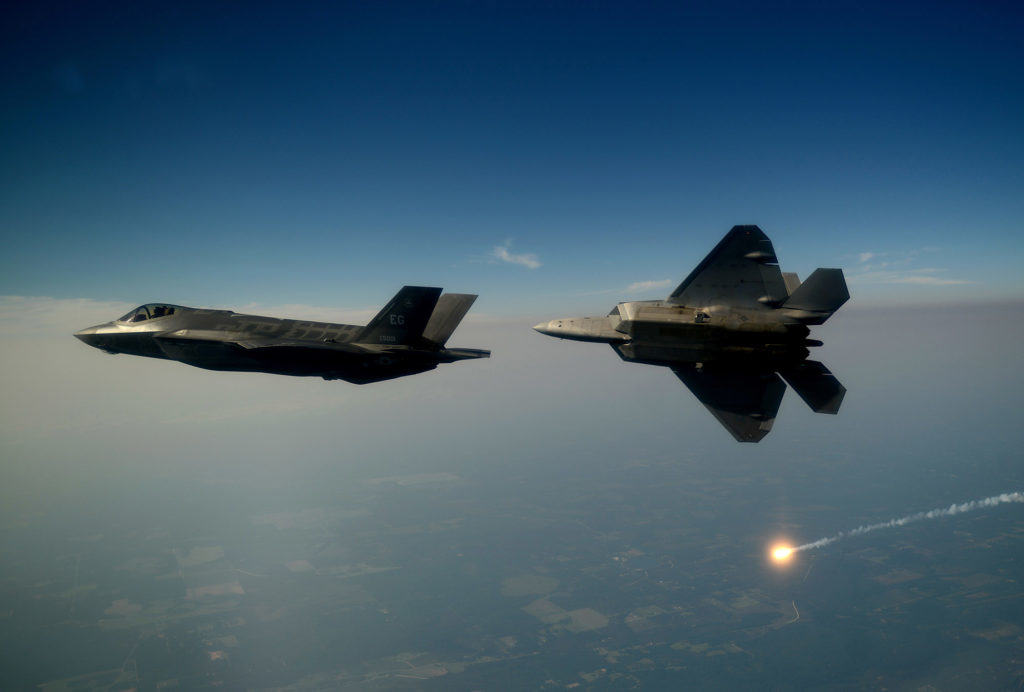
NATIONAL HARBOR, Md. — In spite of recent setbacks that grounded 15 F-35s right after the Air Force declared them ready to go to war, service officials at the Air Force Association’s annual gathering outside of Washington DC presented a measured if not upbeat assessment of the program’s progress and how the airplane will improve air dominance.
“I will tell you, in my opinion, that over time, although there are sometimes bumps in the road and you really don’t always get everything the way you want to to being with, as we develop and field this airplane and we get it into the hands of our airmen and allow them to do with it what they’re capable of doing, I firmly believe this airplane will continue to get better and better and better,” Gen. “Hawk” Carlisle, head of the Air Combat Command, said during his opening remarks. “It’s a great airplane.”
Carlisle was followed by Lt. Gen. Chris Bogdan, the Joint Strike Fighter program head, who contextualized the state of the F-35 in terms of the problems engineers and test team members have solved.
“I would tell you that if you build a test program and you don’t find anything wrong then you didn’t do a good enough job,” Bogdan said. “So it’s not a surprise to me that on any given day we encounter things wrong with this airplane. What I like to tell people is now is the time to find those things and fix them.”
Bogdan listed the most recent problem — one involving faulty insulation around the engines — that grounded 15 airplanes as a “perfect example.”
“If this problem was found three or four years from now we have hundreds of airplanes out there,” Bogdan said. “The mark of a good program isn’t that you have no problems. The mark of a good program is you find things early, you fix them, you make the airplane better, you make the weapons system better, and you move on.
“I think we have a pretty good track record of doing that over the last few years,” he continued. “We don’t talk about engine fires anymore. We don’t talk about a hook on the ‘C’ model that doesn’t catch a cable. We don’t talk about a helmet that has multiple problems with it — in fact, talk to the aviators about how much they like this helmet. We don’t talk about landing gear problems. All of those things are behind us.”

“I’m hopeful that as we grow the fleet that we all take the time to form opinions on this airplane from experts,” Brig. Gen. Scott Pleus, Director of the Pentagon’s F-35 Integration Office, said. “And the only experts in the F-35 business are those that fix, maintain, and fly the F-35 on a day-to-day basis.”
Scott claimed that pilots flying the F-35 out of Luke AFB and Eglin AFB, when polled about what airplane they’d want to be in if faced with an enemy pilot of equal ability today, unanimously chose the F-35 over the F-15C, F-15E, F-16, or A-10 in a “beyond visual range” environment and picked the F-35 by a factor of 80 percent over those other airplanes in a dogfight.
Col. David Lyons, commander of the 388th Fighter Wing, explained that the Air Force’s Initial Operational Capability, or “IOC,” ruling was organized into four categories: availability, deployability, access to required support equipment, and the readiness of trained aircrew, maintenance, and support personnel.
“Our achievement of each IOC milestone gave us increased confidence,” Lyons said. “The outcome speaks for itself. The jet has proved to be both survivable and lethal while allowing the technological growth required to become a viable weapons system for decades to come.”
Lyons touted that the 7-aircraft “graduation” detachment based out of Mountain Home AFB last year yielded a 97.5 percent hit rate for dropped bombs, a 92.3 percent mission capable rate, and 100 percent sortie completion rate — all of which exceed the standards set by the legacy aircraft the F-35 is supposed to replace. He also stated there were zero F-35 losses from “Red Air,” the term used for simulated enemy aircraft in a training scenario.
Lyons characterized his overall impressions of the jet as “overwhelmingly positive.”
“It’s a pilot’s airplane and the technology will prove to be game-changing,” he said. “I think our adversaries will worry, and I think they have every reason to feel that way.”
The sanguine outlook of the high-ranking panel at the Air Force Association Convention was mitigated by the recent news that 57 jets — 15 in operational use and 42 on the production line — had substandard tubing that caused insulation to migrate into fuel tanks. The discovery resulted in the fleet airplanes being grounded while technicians perform an intrusive procedure to remove the insulation by drilling through the wing to access the fuel tanks. Bogdan said he expects the affected jets to be back in service sometime in December. He also said the grounding action does not affect the ‘B’ and ‘C’ models of the F-35.


